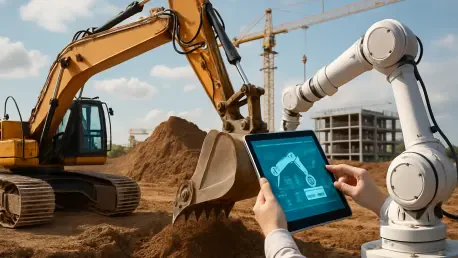The construction industry stands at a pivotal moment where the raw power of hydraulics meets the precision of automation, fundamentally reshaping how projects are executed across job sites worldwide. For decades, hydraulic systems have been the muscle behind heavy machinery like excavators and bulldozers, delivering the force needed for digging, lifting, and grading with unmatched efficiency. Now, with the integration of digital technologies such as sensors, software, and machine learning, these systems are evolving into intelligent tools that not only enhance productivity but also tackle pressing challenges like fuel consumption and environmental impact. This convergence is more than a technical upgrade; it represents a shift toward smarter, more sustainable practices that are redefining the landscape of construction. From improved operator performance to energy recovery innovations, the synergy of steel and software is setting a new standard for what’s possible in this vital sector.
The Digital Revolution in Hydraulic Systems
The foundation of modern construction equipment has always been hydraulics, prized for their ability to handle immense loads with precision and speed in demanding environments. However, the transformation happening today goes beyond traditional mechanics. By embedding sensors into hydraulic systems, real-time data on pressure, flow, and cylinder speed is captured and analyzed, allowing software to make instantaneous adjustments. This digitalization replaces outdated manual controls with algorithms that optimize every movement, slashing inefficiencies and ensuring tasks like excavation or material handling are completed with pinpoint accuracy. The result is a dramatic reduction in wasted effort and resources, enabling contractors to meet tight deadlines while maintaining high standards of quality on complex projects.
This shift from purely mechanical to intelligent systems marks a turning point for the industry, as hydraulics are no longer just a source of power but a hub of actionable insights. These smart setups can adapt to varying conditions—such as soil density or weather—by processing environmental data on the fly, ensuring consistent performance without constant human input. Pioneering companies are driving this change by retrofitting existing machinery with automation solutions, turning conventional equipment into semi-autonomous units. This not only extends the lifespan of older fleets but also bridges the gap to a future where technology and human oversight work in seamless tandem, setting the stage for even greater advancements in operational capabilities.
Boosting Operator Efficiency Through Automation
One of the most immediate benefits of combining automation with hydraulics lies in its ability to enhance operator performance across skill levels on construction sites. Variability in expertise has long been a challenge, with studies showing productivity gaps of up to 30% between average and elite operators handling heavy equipment. Automation addresses this disparity by integrating tools like LiDAR for detailed 3D mapping and machine learning algorithms that suggest optimal paths for digging or lifting. These technologies act as a virtual coach, guiding operators in real time to minimize errors and avoid redundant actions, thereby ensuring consistent output regardless of experience. This democratization of skill not only boosts morale but also helps firms maximize their workforce potential.
The practical outcomes of such advancements are striking, with measurable gains that directly impact project bottom lines and timelines in the construction sector. Consider a 100-ton excavator equipped with automated hydraulic controls: reports indicate fuel savings of up to 20% and productivity increases of around 10% simply by optimizing motion and reducing unnecessary cycles. By automating repetitive tasks and fine-tuning each operation, machinery achieves efficiency levels that manual control could rarely match. This translates to faster project completion, lower operational costs, and a competitive edge for companies adopting these systems, all while maintaining safety standards in high-pressure environments where precision is paramount.
Sustainability and Economic Advantages of Smart Hydraulics
Beyond performance, the integration of automation into hydraulic systems offers compelling environmental and economic benefits that align with the industry’s evolving priorities. Intelligent designs now incorporate energy recovery mechanisms, capturing power during actions like lowering a boom or decelerating equipment, which can then be reused to reduce overall fuel consumption. This not only cuts costs in an era of fluctuating fuel prices but also lowers emissions, helping firms comply with increasingly stringent environmental regulations. As sustainability becomes a core metric for success, these innovations position construction companies to meet global standards while contributing to a greener footprint on every project they undertake.
Economically, the advantages extend to long-term savings and operational resilience, reinforcing the case for adopting these technologies across diverse job sites. Smart hydraulics enable predictive maintenance by monitoring system health in real time, flagging potential issues before they lead to costly downtime or repairs. This proactive approach minimizes disruptions and extends equipment lifespan, offering a strong return on investment. Moreover, the focus on operator assistance—rather than full replacement—ensures that technology remains accessible, blending seamlessly into existing workflows without requiring drastic overhauls. This balance of cost-effectiveness and environmental responsibility underscores why the shift to automated hydraulics is not just a trend but a necessary evolution for the industry’s future.
Human-Centric Automation and Future Pathways
While the vision of fully autonomous construction machinery is on the horizon, the current emphasis lies in human-centric automation that amplifies rather than replaces the workforce. Assisted control systems, powered by advanced hydraulics and software, provide operators with real-time feedback and decision-making support, enhancing their capabilities without sidelining their expertise. This approach ensures smoother adoption across varied job sites, from urban developments to remote mining operations, where conditions and challenges differ widely. By prioritizing collaboration between human skill and machine intelligence, the industry is fostering a transition that feels practical and inclusive, addressing immediate needs while building trust in emerging technologies.
Looking ahead, the trajectory for this technological fusion points to a phased rollout of even more sophisticated solutions over the coming years. Starting now, operator guidance tools are expected to become standard in high-output sectors like infrastructure within the next five years, from 2025 onward. Beyond that, electro-hydraulic hybrids and AI-driven diagnostics could dominate within a decade, paving the way for modular autonomy systems. These developments promise to further refine efficiency and sustainability, ensuring that construction machinery evolves in step with global demands. The focus remains on creating equipment that not only moves earth but also moves the industry toward a smarter, more responsible future through strategic innovation.
Reflecting on a Transformative Shift
Looking back, the convergence of automation and hydraulics marked a defining chapter for construction, as it reshaped the capabilities of heavy machinery with unprecedented precision and foresight. Digital tools turned raw mechanical power into intelligent systems that adapted to real-world challenges, while operator assistance bridged skill gaps and drove efficiency to new heights. Energy recovery and predictive maintenance emerged as cornerstones of sustainability and cost savings, aligning the sector with broader environmental goals. As this transformation unfolded, the industry witnessed a balanced approach that empowered workers while laying the groundwork for future autonomy. Moving forward, stakeholders should prioritize scalable adoption of these technologies, invest in training to maximize human-machine collaboration, and explore partnerships to accelerate innovation, ensuring that the momentum of this shift continues to build a more efficient and sustainable construction landscape.









